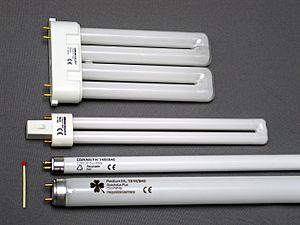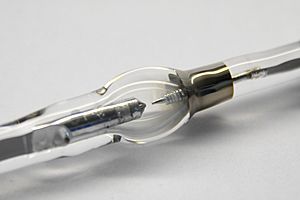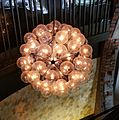Light bulb facts for kids
A light bulb is a device that creates light from electricity. Besides lighting up dark places, light bulbs are used for many other things. They can show if an electronic device is on, help direct traffic, and even provide heat. Billions of light bulbs are used all over the world, even in outer space!
Long ago, people used candles and oil lamps for light. Simple electric lights were made in the early 1800s but weren't very useful. Later in the 1800s, better technology made them shine brighter and last longer. Soon, electric power stations brought electricity to homes and cities to power these new lights. Even newer lights, like fluorescent bulbs, use less electricity to make more light.
Contents
Different Kinds of Light Bulbs
Incandescent Light Bulbs
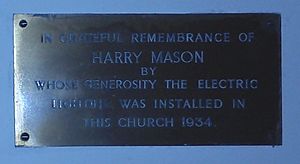
Modern incandescent light bulbs have a thin, coiled wire called a filament, usually made of tungsten. This filament is sealed inside a glass bulb that either has no air (a vacuum) or is filled with a special gas like argon. When electricity flows through the tungsten filament, it gets super hot (over 1,700°C!) and glows, making light.
Incandescent bulbs are not very energy efficient. Only about 2-5% of the electricity they use turns into light we can see. The other 95% is lost as heat. In warm places, this extra heat can make rooms hotter, meaning you might need more air conditioning. In cold places, the heat can be useful, like in heat lamps. Because they use so much energy, many countries are now replacing incandescent bulbs with more efficient ones like CFLs and LED bulbs.
Halogen Light Bulbs
Halogen lamps are usually much smaller than regular incandescent bulbs. They need to get very hot (over 200°C) to work well. Because of this, their bulbs are often made of strong glass like quartz. This glass is sometimes sealed inside another layer of glass for safety. The outer glass helps block harmful ultraviolet light and keeps hot glass pieces contained if the inner bulb breaks. If you touch a halogen bulb with oily fingers, the oil can cause the hot quartz glass to shatter.
Halogen bulbs that run on 12 or 24 volts have small filaments, which helps them direct light very well. They also use less energy and last longer than regular incandescent bulbs. Their light stays bright and strong throughout their life.
Fluorescent Light Bulbs
Fluorescent lamps are glass tubes filled with a small amount of mercury vapor or argon gas. When electricity flows through the tube, these gases give off ultraviolet (UV) energy. The inside of the tube is coated with special powders called phosphors. When the UV light hits these phosphors, they glow and produce visible light.
Fluorescent lamps are much more efficient than incandescent lamps. They typically use only about one-quarter to one-third of the electricity to make the same amount of light. While fluorescent light fixtures cost more at first because they need a special device called a ballast to control the electricity, they save money on energy bills over time. Compact fluorescent lamps (CFLs) are popular energy-saving options for homes. Because they contain mercury, many fluorescent lamps are considered hazardous waste. It's important to recycle them properly instead of throwing them in the trash.
LED Light Bulbs
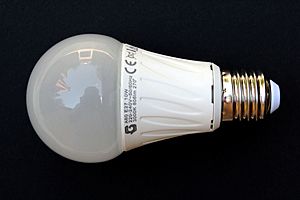
Light-emitting diodes (LEDs) have been used as small indicator lights in electronics since the 1970s. In the 2000s, LEDs became bright and efficient enough to be used for lighting. You can now find them in car headlights, flashlights, and even holiday lights. Indicator LEDs can last an incredibly long time, sometimes up to 100,000 hours! However, LEDs used for general lighting are often run harder, so they might not last quite as long.
LED technology is great for lighting because it uses little power, doesn't get very hot, turns on and off instantly, and keeps its color consistent. The lifespan of an LED lamp depends a lot on how hot the diode gets. If it gets too hot inside, the lamp's life can be much shorter.
Carbon Arc Lamps
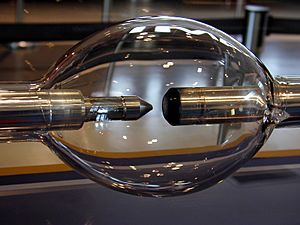
Carbon arc lamps use two carbon rods as electrodes in the open air. When electricity flows and the rods touch then separate, it creates a bright electric arc of white-hot plasma between them. These lamps are brighter than filament lamps, but the carbon rods burn away quickly and need to be adjusted often. They also produce a lot of ultraviolet light and need good ventilation if used indoors. Their intense brightness means you shouldn't look directly at them.
Invented around 1805 by Humphry Davy, the carbon arc was the first useful electric light. It was used for street lighting and large buildings starting in the 1870s. By the early 1900s, incandescent lights replaced them for most uses. Carbon arc lamps are very powerful and produce a strong, white light from a small point. They were still used in special places like movie projectors, stage lighting, and searchlights until after World War II.
Discharge Lamps
A discharge lamp has a glass tube with two metal electrodes separated by a gas. Common gases used include neon, argon, xenon, sodium, and mercury. The basic idea is similar to carbon arc lamps, but "arc lamp" usually refers to the older carbon type. Some discharge lamps need a very high voltage to start the arc, which comes from a special part of the electrical ballast called an igniter. Once the arc starts, the ballast then limits the electricity flowing through the lamp. Without a ballast, too much electricity would flow and quickly destroy the lamp.
Some lamps, like low-pressure sodium lamps, have a small amount of neon that helps them start with normal voltage, so they don't need a special igniter. The simplest ballasts are just a coil of wire and are used where cost is important, like in street lights. More advanced electronic ballasts can keep the light bright throughout the lamp's life, make the light flicker-free, and even shut down if there's a problem.
The most efficient electric light source is the low-pressure sodium lamp. It produces a very specific orange-yellow light, which makes everything look orange-yellow. Because of this, it's mostly used for outdoor public lighting. Astronomers like low-pressure sodium lights for public lighting because the light pollution they create can be easily filtered out, unlike other types of light.
Light Bulb Safety Tips
- Most light bulbs screw into a socket that carries a high level of electricity. If the socket is turned on, even if the bulb is out, there is a real risk of an electric shock. Always turn off the power before changing a bulb.
- Incandescent bulbs get very hot when they are on. They take some time to cool off after being turned off. Touching a hot bulb can cause burns.
- Most light bulbs are made of glass, which means they can break easily. Broken glass has sharp edges that can cut your skin. Be careful when handling bulbs.
- If a fluorescent bulb breaks, the small amount of mercury inside can release vapor. Breathing in this vapor can be harmful. If a fluorescent bulb breaks, open windows and leave the room for a while, then carefully clean it up following safety guidelines.
Fun Facts About Light Bulbs
- In Western culture, a light bulb appearing above someone's head often means they've had a sudden, brilliant idea!
- One of the world's first electric light bulbs was made by Warren de la Rue in 1840.
- The first practical LED was created in 1962.
- Electric lamps can also be used as heat sources. For example, they are used in incubators for eggs, as infrared lamps in fast food restaurants to keep food warm, and in toys like the Kenner Easy-Bake Oven.
- Lamps can be used for light therapy to help with things like vitamin D deficiency, skin conditions such as acne and dermatitis, and even seasonal affective disorder (SAD).
- In the United States, some compact fluorescent bulbs have been banned because of their toxic mercury content.
Related Pages
Images for kids
See also
 In Spanish: Luz eléctrica para niños
In Spanish: Luz eléctrica para niños



